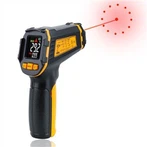Common faults of stereo microscopes and their troubleshooting methods
Stereoscopic microscopes are widely used in various sectors of industry, agriculture and scientific research because of their many advantages. If there are some problems during use, you can solve them yourself according to the actual situation. Common faults based on actual usage include: the field of view is blurred or there is dirt. Possible reasons include dirt on the specimen, dirt on the surface of the eyepiece, dirt on the surface of the objective lens, and dirt on the surface of the work plate.
1. Focusing: Place the worktable into the tabletop mounting hole on the base. When observing transparent specimens, use a frosted glass platen; when observing opaque specimens, use a black and white platen. Then loosen the fastening screw on the focusing slide and adjust the height of the lens body to a working distance that is roughly consistent with the magnification of the selected objective lens. After adjustment, the tightening screw must be tightened. When adjusting the focus, it is recommended to use flat objects, such as flat paper with characters printed on it, a ruler, a triangle, etc. Diopter adjustment: First adjust the diopter rings on the left and right eyepiece tubes to the 0 mark position. Normally, look through the right eyepiece tube first.
Turn the zoom handwheel to the lowest magnification position, turn the focus handwheel and diopter adjustment ring to adjust the specimen until the image of the specimen is clear, then turn the zoom handwheel to the highest magnification position and continue to adjust until the image of the specimen is clear. At this time, observe with the left eyepiece tube. If it is not clear, adjust the diopter ring on the left eyepiece tube axially until the image of the specimen is clear.
2. Interpupillary distance adjustment: Pull the two eyepiece tubes to change the exit pupil distance of the two eyepiece tubes.
When the two circular fields of view in the user's field of view completely overlap, it means that the interpupillary distance has been adjusted properly. It should be noted that due to individual differences in vision and eye adjustment, when different users or even the same user use the same stereomicroscope at different times, they should make parfocal adjustments separately in order to obtain the best observation. Effect. Whether you are replacing the upper light bulb or the lower light bulb, be sure to turn off the power switch and unplug the power cord from the power socket before replacement.
When replacing the upper light source bulb, first unscrew the knurled screws of the upper light source light box, remove the light box, then remove the bad bulb from the lamp holder, replace it with a good bulb, and then install the light box and knurled screws. When replacing the light source bulb, you need to take out the frosted glass tabletop or black and white tabletop from the base, then remove the bad bulb from the lamp holder and replace it with a good bulb; then install the frosted glass tabletop or black and white tabletop. . When replacing the bulb, please wipe the bulb glass bulb clean with a clean soft cloth or cotton gauze to ensure the lighting effect.






